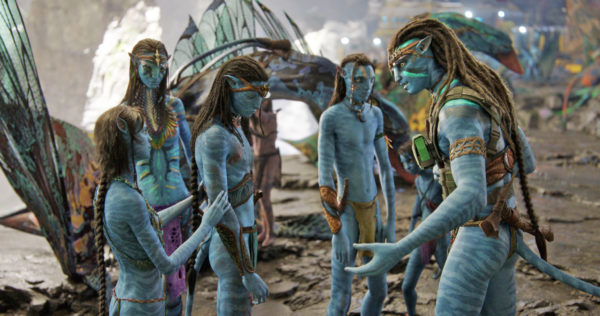
13 years after delivering the highest grossing film of all time, James Cameron is back with the sequel to Avatar, entitled The Way of Water. Is there still life (and money) to be found on Pandora?
In short: absolutely. By this point we should have learned (at least twice) to stop doubting Cameron about the critical and commercial viability of his big budgeted spectacles (see: 1997’s Titanic and the original 2009 Avatar).
The sequel reunites nearly everyone from the original cast and opens as Jake Sully (Sam Worthington) catches the audience up via voice-over about his life with Neytiri (Zoe Saldaña). This now includes a robust family: eldest (aka dutiful) son Neteyam (Jamie Flatters), troublemaking second son Lo’ak (Britain Dalton), and youngest daughter Tuk (Trinity Jo-Li Bliss). The pair also have two “adopted” kids: Kiri (Sigourney Weaver), the biological daughter of Dr. Grace Augustine and born of immaculate conception, as well Spider (Jack Champion), a near-feral human boy who was left on Pandora after the “Sky People” were sent packing after the events of the first film.
For the most part Cameron’s script, co-written with Rick Jaffa, Amanda Silver, Josh Friedman, and Shane Salerno, leans into fairly traditional storytelling devices. The Way of Water explores the bonds of family, sacrifice and letting your children grow and become their own person. While the family has grown, it’s principally focused on Sully, who orders his children around like an Army unit, and Lo’ak, who is desperate to please his father by becoming a warrior, though his impulsive behaviour has dire and dangerous consequences.
Tensions escalate when the Sky People unexpectedly return to colonize the planet as a new settlement for Earth (yes, the first film’s environmental messaging remains intact). When we catch back up with Jake a year later, he and the N’avi have become emboldened fighters who routinely ambush transport trains and helicopters to disrupt the humans’ supply chain. This doesn’t sit well with General Frances Ardmore (Edie Falco, in a thankless role that will presumably be bigger in future sequels), who orders Colonel Miles Quaritch (Stephen Lang), now living as a N’avi Avatar to track down Sully.
This is more or less the inciting incident for the film’s new adventures: with a bullseye on the family, Sully and his family flee the forests for the sanctuary of the Metkayina reef people clan, where they lay low and attempt to acclimatize to a new way of life. This affords Cameron and the Weta FX team to introduce both an entirely new aquatic ecosystem, as well as a different Indigenous population, which includes Cliff Curtis‘ Chief Tonowari, Kate Winslet as his wife Rona, Bailey Bass as daughter Reya and Filip Geljo as their son Aonung.

The early scenes of life among the Metkayina clan are filled with sibling and romantic rivalry, dazzling underwater sequences and the film’s most impressive new character: Payakan, a massive and intelligent whale-like creature that Lo’ak befriends after a hazing ritual gone wrong. The new environment and conflict between the family and the Metkayina dominates the first two acts of the film to such an extent that audiences would be forgiven for forgetting about Quaritch’s vendetta. It’s almost disappointing when the character suddenly returns to dominate the film, commandeering the fishing vessel of brutish Captain Mick Scoresby (Brendan Cowell) and setting up a tantalizing future storyline with marine biologist Dr. Ian Garvin (Jemaine Clement) involving immortality.
As Quaritch tightens the net – literally and figuratively – Jake’s pacifist refusal to fight is mirrored by Payakan’s backstory and derided by Neytiri, who believes they have a responsibility to protect more than just their family. Unsurprisingly the entire last act is dedicated to a series of large-scale battles; this time mostly set on and under the water, thereby allowing Cameron to use his extensive diving expertise and continue to push the limits of the film’s already impressive CGI.
While the narrative is pretty standard family fare, it’s still enjoyable and even occasionally emotional. Criticisms of predictability aside (audiences won’t be surprised by a single plot “twist”, character beat or death), The Way of Water is first and foremost a visual spectacle aimed squarely at dominating all four quadrants of the holiday box office.
By far the biggest selling feature is the FX, which is so convincing and impressive that it makes other mainstream blockbusters look dated and inferior. The Way of Water may have a bloated runtime and familiar storyline, but it also feels like the first film in ages – aside from Top Gun: Maverick – to truly justify an expensive trip to the multiplex.
Avatar: The Way of Water is an immersive, visual spectacle that easily and successfully recaptures that sense of awe and fun on the big screen, which is a rare and uncommon event these days.
James Cameron has scored another home run. 4/5
Avatar: The Way of Water is now out in theaters. See it on as big a screen in 3D as you can